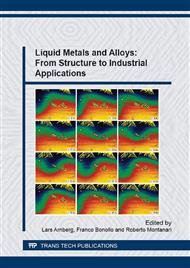[1]
C.T. Sims, N.S. Stoloff, W.C. Hagel in Superalloys II, Wiley, New York, (1986).
Google Scholar
[2]
R.C. Reed, The superalloys: fundamentals and applications, Cambridge University Press, (2006).
Google Scholar
[3]
D. Locq, A. Walder, M. Marty, P. Caron, in Development of New PM Superalloys for High Temperature Applications, Proc. of EUROMAT, Intermetallics and Superalloys Vol. 10, WILEY-VCH Verlag Gmbh, Weinheim, Germany, (2000).
DOI: 10.1002/3527607285.ch9
Google Scholar
[4]
H. Monjati, M. Jahazi, R. Bahrami, S. Yue, Mater. Sci. Eng. A 373 (2004) 286-293.
Google Scholar
[5]
A.M. Ges, O. Fornaro, H.A. Palacio, Mater. Sci. Eng. A 458 (2007) 96-100.
Google Scholar
[6]
W. Betteridge, J. Heslop in The Nimonic Alloys, and Other Nickel-Base High-TempratureAlloys, New York, (1974).
Google Scholar
[7]
M. Tresa Pollock, T. Sammy in Nickel-Based Superalloys for Advanced Turbine Engines: Chemistry, Microstructure, and Properties, University of Michigan, Ann Arbor, Michigan 48109, University of Cambridge, Cambridge, England CB2 3QZ, United Kingdom, (2006).
Google Scholar
[8]
P. Deodati, R. Montanari, O. Tassa, N. Ucciardello, Mater. Sci. Eng. A 521-522 (2009) 102-105.
Google Scholar
[9]
S.A. David, J.M. Vitek, S.S. Babu, Welding of nickel base superalloy single crystals, ORNL TN 37831-6095.
Google Scholar
[10]
O.A. Ojo, N.L. Richards, M.C. Chaturvedi, Microstructural study of weld fusion zone of TIG welded IN 738LC nickel-based superalloy, Scripta Materialia 51 (2004) 683-688.
DOI: 10.1016/j.scriptamat.2004.06.013
Google Scholar
[11]
M.B. Henderson, D. Arrell, M. Heobel, R. Larsson, G. Marchanty, Nickel-Based Superalloy Welding Practices for Industrial Gas Turbine Applications, Science and Technology of Welding and Joining 9 (2013)13-21.
DOI: 10.1179/136217104225017099
Google Scholar
[12]
M.V.R.S. Jensen, D. Dye, K.E. James, A.M. Korsunsky, S. M. Roberts, R. C. Reed, Residual stresses in a welded superalloy disc: Characterization using synchrotron diffraction and numerical process modeling, Metall. Trans. A, 33A(9) (2002).
DOI: 10.1007/s11661-002-0277-0
Google Scholar
[13]
D.S. Duvall, W.A. Owezarski, D.F. Paulonis, Transient Liquid Phase Bonding: A New Method for Joining Heat Resistant Alloys, Weld J., 53 (1974) 203-214.
Google Scholar
[14]
G.S. Hoppin, T.F. Berry, Activated diffusion bonding, Weld J. 11 (1970) 505-509.
Google Scholar
[15]
J. Lescourges, Proc. of AGARD Specialist Meeting, Oberammergau (1985).
Google Scholar
[16]
A.A. Shirzadi, E.R. Wallach, Temperature gradient transient liquid phase diffusion bonding: a new method for joining advanced materialsSci. Techn. Weld. Join. 2 (3) (1997) 89-94.
DOI: 10.1179/stw.1997.2.3.89
Google Scholar
[17]
C. Pascal, R.M. Marin-Ayral, J.C. Tedenac, C. Merlet, Combustion synthesis: a new route for repair of gas turbine components-achievements and perspectives for development of SHS rebuilding, J. Mater. Proc. Techn. 135 (2003) 91-100.
DOI: 10.1016/s0924-0136(02)01047-6
Google Scholar
[18]
F. Zapirain, F. Zubiri, F. Garciandía, I. Tolosa, S. Chueca, A. Goiria, Development of laser welding of Ni based superalloys for aeronautic engine applications (experimental process and obtained properties), Phys. Procedia 12 (2011) 105-112.
DOI: 10.1016/j.phpro.2011.03.014
Google Scholar
[19]
G.Q. Chen, B. Zhang, T. Lu, J.C. Feng, Causes and control of welding cracks in electron-beam-welded superalloy GH4169 joints, Trans. Nonferrous Met. Soc. China 23 (2013) 1971-(1976).
DOI: 10.1016/s1003-6326(13)62685-0
Google Scholar
[20]
M.T. Rush, P.A. Colegrove, Z. Zhang, B. Courtot, An investigation into cracking in nickel-base superalloy repair welds, Adv. Mater. Res. 89-91 (2010) 467-472.
DOI: 10.4028/www.scientific.net/amr.89-91.467
Google Scholar
[21]
Xiu-Bo Liu, Gang Yu, Jian Guob, Yi-Jie Gu, Ming Pang, Cai-Yun Zheng, Heng-Hai Wang, J. Alloy Comp. 453 (2008) 371-378.
Google Scholar
[22]
Huei-Sen Wang1, Chih-Ying Huang, Kuen-Sen Ho, Sian-Jhih Deng, Mater. Trans. 52-No. 12 (2011) 2197-2204.
Google Scholar
[23]
D.J. Tillack, Welding Journal 86 (2007) 28-32.
Google Scholar
[24]
R. Montanari, A. Varone, G. Barbieri, P. Soltani, S. Kaciulis, Welding of IN792 DS superalloy by electron beam, Surf. Interf. Anal., 48 (2016).
DOI: 10.1002/sia.5946
Google Scholar



